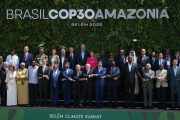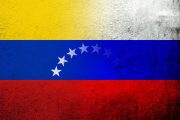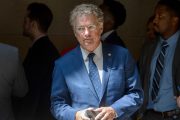“It’s a new day. Communism is dead. It’s even dead in Cuba.” So declared Senator Barbara Boxer (D-Calif.) at a Senate Commerce Committee hearing in May 2002. “I hate to say it,” she continued, “it’s dead.” The senator’s proclamation was a surprise, no doubt, to Fidel Castro, whose regime was (and is) alive and as Red as ever. It also must have come as welcome news to the people of Cuba, still suffering, after nearly half a century, under Fidel’s stifling oppression. Unfortunately, for them, the senator was wrong, as usual.
Conservatives had a field day blasting Senator Boxer’s ridiculous epitaph. But while ridiculing her forensic pathology regarding Cuba, her critics frequently repeated Boxer’s error by proclaiming that “communism is dead” in the rest of Latin America.
The supposed corpse of communism, however, is very much alive. In fact, it is much more dangerously alive than it was when Castro was in his heyday, in the 1960s and ’70s, sponsoring revolution and terrorism throughout the Americas, Africa, and the Middle East. Consider:
• For the past six years, President Hugo Chavez — a self-proclaimed communist and boon companion of Fidel — has been tightening the vise of dictatorship on Venezuela, the region’s key oil-producing country (and the source of much of our imported fuel).
• Next door in Brazil, Latin America’s largest, most populous nation, President Luiz Inácio Lula da Silva is also consolidating a Marxist regime.
• In Argentina, President Nestor Kirchner reversed 15 years of Argentine policy by re-establishing ties with Cuba and cozying up to Castro and Hugo Chavez.
• In Ecuador, radical Castro-Chavez protégé Lucio Gutiérrez is now in control.
• Much of Colombia is controlled by FARC, the communist narco-terrorists who have been waging a murderous terrorist war for 40 years.
• United Nations “peacekeepers” occupy Haiti, and that disaster-ridden island may soon see the return of ousted Marxist madman Jean-Bertrand Aristide.
• Riots in Bolivia caused President Lozada to resign in 2003, and the current president, Carlos Mesa, may soon be replaced by Evo Morales, “indigenous” activist and leader of the Movement Toward Socialism (MAS) party. In the December 2004 local elections, Morales’ MAS candidates won many of the city and provincial races.
• The communist Sandinistas have swept back into power in Nicaragua, taking many of the local offices in the November 2004 elections.
The leftist list goes on: Chile’s Ricardo Lagos (elected in 2000), Peru’s Alejandro Toledo (2000), and Uruguay’s Tabaré Vázquez (2004). Latin American countries are falling like dominoes. But scarcely anyone is mentioning the Domino Theory — no, make that Domino Reality — playing out right next door.
Mention of the Domino Theory tends to draw blank stares from the under-40 set today. During the 1950s, ’60s, and ’70s, however, it was a household word and a central tenet of U.S. and Western geo-strategy in relation to the Soviet Union, China, and the Soviet-bloc countries. If the West didn’t oppose the communist forces backed by Moscow and Beijing, the theory went, the countries of Laos, Cambodia, and Vietnam would fall to communism, one by one, in quick succession. Millions of people would be slaughtered, and whole nations would be turned into concentration camps. The Asian nations in the region that didn’t fall to overt communist takeover would come under Red China’s dominance, nonetheless.
The liberal intelligentsia sneered at such “simplistic” and “paranoid” notions. They were wrong, of course — fatally, horribly wrong. The “simplistic” theory proved to be fact. Laos, Cambodia, and Vietnam did fall like dominoes. Millions were slaughtered, and the survivors were enslaved in concentration camps. The rest of Asia has come under China’s economic and military dominance.
During the same period that the Asian dominoes were being set up for their tragic fall (the 1950s, ’60s, and ’70s), a similar scenario was developing much closer to home, on our southern doorstep. Fidel Castro took Cuba and used it as a revolutionary launch pad for the hemisphere. The dominoes began falling in Latin America to Soviet-backed thugs and terrorists: Romulo Betancourt in Venezuela, Cheddi Jagan in British Guiana, Juan Bosch in the Dominican Republic, Juan José Arévalo in Guatemala, Janio Quadros and Joao Goulart in Brazil, Victor Paz Estenssoro in Bolivia, Salvador Allende in Chile, Omar Torrijos in Panama, Maurice Bishop in Grenada, and the Sandinistas in Nicaragua.
But communist regimes never stuck in Latin America. The major reason: geography. The Russian and Chinese communists could not consolidate control by simply marching in massive occupying armies, like they did in Central and Eastern Europe and Central and Southeast Asia. Except for Cuba, that is, where the Kennedy administration gave Castro a security guarantee, pledging not to attempt to overthrow him, and not to allow anyone else to do so either — so long as the Russians removed their missiles. But outside of Castro’s protected “workers’ paradise,” anti-communist forces (often from the military) regularly toppled the Moscow-Havana puppets.
Terrorists-’R’-Us
During the 1990s, while establishment analysts were proclaiming communism dead in Latin America, Castro was busily building a hemispheric network that would focus on taking power by the ballot as well as the bullet. One of the most important parts of that network is the São Paulo Forum, a veritable Who’s Who of terrorist groups and revolutionary parties that proudly boasts regular attendance by national presidents, other prominent politicians, labor leaders, and NGOs (non-governmental organizations).
The São Paulo Forum (SPF) was created in São Paulo, Brazil, in 1990, under the official sponsorship of Fidel Castro and Brazil’s Communist Workers Party, headed by Lula da Silva, now president of Brazil. Member organizations of the SPF include the Communist Parties of Argentina, Brazil, Chile, Cuba, Ecuador, El Salvador, Mexico, Nicaragua, Peru, Puerto Rico, Uruguay, and Venezuela. “Former” terrorist groups that have gone political, such as Nicaragua’s Sandinistas and El Salvador’s FMLN, are also SPF members. So are organizations that are currently on the U.S. State Department’s list of active terrorist groups, such as Colombia’s FARC and ELN, the Tupac Amaru of Peru, Chile’s MIR, and the Basque ETA of Spain.
The SPF conferences regularly feature guests and observers from communist governments such as North Korea and Vietnam, as well as the Communist Party of the United States, the Palestine Liberation Organization, and Sinn Fein (the political arm of the terrorist Irish Republican Army, IRA). In short, the SPF is a global Terrorists-’R’-Us, where leaders of terrorist states and terrorist groups are allowed to vote and are given a podium from which to pontificate on human rights, justice, and democracy. Besides Cuba’s Fidel Castro, SPF stalwarts include Brazil’s Lula, Venezuela’s Chavez, Ecuador’s Gutierrez, Uruguay’s Vazquez, and many other current and former government leaders.
Amazingly, the meetings, deliberations, and connections of the São Paulo Forum rarely merit even a mention in the major U.S. media. Nor do members of Congress or the Bush administration express concern over SPF membership when ladling out more foreign aid, or when planning political and economic “integration” with these new “partners” under bilateral trade agreements or the proposed 34-nation Free Trade Area of the Americas (FTAA). And while the White House and the internationalist architects of the FTAA herald the progress they are making toward “hemispheric security,” many of the Latin American regimes they are partnering with are deep in bed with the drug cartels, narco-terrorist groups, and a vast and growing array of Middle Eastern terrorist groups — Hezbollah, Islamic Jihad, al-Qaeda, Hamas, and PLO — that have established a huge presence, especially in Venezuela and in the Tri-Border Area of Brazil, Paraguay, and Argentina.
The São Paulo Forum is a continuation and expansion of the Tricontinental Conference, the Soviet terror operation that spawned the modern global terrorist phenomenon four decades ago. The Tricontinental made its debut appearance in 1966 with a gathering of world terrorist leaders in Havana. Although it was hosted by Fidel Castro, who became the titular head of the ongoing Tricontinental terror wave, the whole affair was completely a Moscow-run global strategic offensive. Planning for the Tricontinental had been set in motion by the Soviet Politburo at least as early as 1964, under the guidance of Boris Ponomarev, head of the Kremlin’s International Department. The 1966 Havana conference brought together more than 500 representatives from communist parties, revolutionary organizations, and terrorist groups from around the world. Cuba became the chief center of terrorist training, under the direction of Soviet KGB Colonel Vadim Kochergine and 10,000 Soviet military “advisers.” Additional communist-bloc trainers from Czechoslovakia, Bulgaria, Romania, and East Germany supplemented Cuba’s massive Soviet contingent.
The direct continuity from the Havana-based Tricontinental Conference to the Sao Paulo Forum can be traced easily through personnel, parties, philosophy, and practice. The personnel/party pedigrees are so obvious that veteran Latin American observers and journalists have to be willfully blind not to notice.
For starters, there’s Fidel himself, kingpin of the Tricontinental and a venerated co-founder of the São Paulo Forum (SPF). Castro has hosted a number of the annual SPF conferences in Havana and has attended most of the other SPF gatherings as they have rotated throughout Latin America. Additional comrades at SPF from the Tricontinental days include Daniel Ortega, Sandinista chief and co-founder of SPF; Shafik Handal, FMLN terrorist group founder and former general secretary of the Communist Party of El Salvador; Leonardo Boff and Frei Betto of Brazil, two of the leading lights of “liberation theology” since the 1960s; Marco Aurelio Garcia, Brazilian communist and SPF executive secretary; Mario Marulanda Vélez, maximum leader of FARC, Colombia’s narco-terrorist army; and Ahmed Ben Bella, former Algerian dictator and 1960s leader of the communist FLN terrorists in Algeria.
The São Paulo Forum is guided by a coordinating body called the Working Group, comprised of the communist parties of Cuba, Brazil, and Uruguay, and representatives of such terrorist groups as the FSLN, FMLN, FARC, and ELN. Like the Tricontinental, the SPF’s conferences are drenched in the Marxist dialectic and replete with denunciations of “Yankee imperialism” and “savage capitalism.”
“Two, Three, Many Vietnams”
In 1966, at the Havana Tricontinental Conference, Castro’s revolutionary sidekick, Che Guevara, called for the “creation of two, three, many Vietnams,” meaning that communists throughout the world should create multiple war fronts that would overwhelm the response capabilities of the U.S. military. Che’s war cry was picked up and echoed by leftists across the globe and has remained a theme of Fidel Castro’s Tricontinental/Sao Paulo Forum axis. Venezuela’s Hugo Chavez is determined to implement Che’s famous war cry and to carry on the communist legacy of his aging compadre, Fidel Castro. Chavez lionizes the “martyred” Che Guevara and was interviewed in 2004 by Che’s daughter, a communist propagandist and physician who lives in Cuba.
Hugo Chavez has made a point of praising, visiting, and embracing the most totalitarian regimes in the world. He was the first head of state to visit Saddam Hussein in Iraq after the Gulf War. He has allied himself closely with Red China, Russia, Iran, Libya, Algeria, Syria, and, of course, Cuba. His administration praises the communist regime of North Korean madman Kim Jong Il — leader of an economic basket case, as well as a human rights hellhole — as a model for Venezuela’s development. On October 12, 1999, during a state visit to China, President Chavez proudly announced: “I have been very Maoist all my life.” He praised Mao Zedong, one of the greatest mass murderers in history, and let it be known that he viewed Chairman Mao’s program as a model for his own Venezuelan revolution.
Chavez calls his program a “Bolivarian revolution,” claiming inspiration from the popular 19th-century South American independence fighter Simon Bolivar. But it is clearly more Marxist and Maoist than Bolivarian. Recognizing that his hold on power was tenuous, Chavez imported thousands of Cuban agents masquerading as teachers, health professionals, scientists, and sports instructors. Their job is to organize his Bolivarian Circles — the communist mobs patterned after Castro’s Committees in Defense of the Revolution. At the same time, Chavez has brought in hundreds of intelligence agents from Castro’s DGI (Cuba’s version of the KGB) to help take over and purge the Venezuelan military and police of counter-revolutionary elements that pose a threat to his total consolidation of power.
In 2003, General Marcos Ferreira resigned as head of Venezuela’s border control agency, DIEX, and presented documents and his own eyewitness accounts of the Chavez government’s close cooperation with global terrorist groups. According to Gen. Ferreira, thousands of fraudulent Venezuelan identities were issued to members of known terrorist groups, including al-Qaeda, on orders from top officials in Chavez’s government.
Reportedly, nearly 4,000 fraudulent documents were issued between 2000 and 2002. The largest batch (2,520) were given to Colombians and the second-largest category (1,279) went to individuals of Middle Eastern origin. Ferreira said that on over 35 occasions he was told by Chavez’s Interior Minister, Rodriguez Chacin, to allow groups of undocumented aliens into the country.
Chacin, who has been Chavez’s principal liaison with Colombia’s FARC narco-terrorist army, repeatedly pressured Ferreira to launder the identities of terrorists and narco-traffickers operating in Venezuela or transiting the country, often en route to or from Cuba. The identities he laundered included those for a network of people who raise funds for the Hezbollah terrorist group in Venezuela. “I quit my job when I got tired of doing dirty work for Chavez with the Cubans looking over my shoulder,” Gen. Ferreira told reporters in October 2003.
Many other government, police, and military officials, including former Chavez loyalists who have become alarmed by his growing totalitarian rule and his increasingly open ties to Cuba and terrorist groups, have provided evidence reinforcing Ferreira’s charges. Air Force Major Diaz Castillo, who fled to the United States in 2002, says that in 2001 he was put in charge of a mission by Chavez to fly $1 million in cash aid to Osama bin Laden in Afghanistan. According to Castillo, he flew the cash to the Venezuelan embassy in New Delhi, India, and it was then funneled through Pakistan — with the assistance of the UN High Commission for Refugees — to al-Qaeda as “humanitarian” assistance.
Colonel Jesús Urdaneta, Venezuela’s former intelligence chief and a former friend and military colleague of Chavez, has produced documents proving that Chavez and Chacin had entered into secret agreements with FARC to provide the terrorists with munitions, money, fuel, and other support. Urdaneta has characterized those agreements as treasonous.
Oil and Revolution
Because Venezuela is blessed with the Western Hemisphere’s largest proven conventional oil reserves, the Chavez regime automatically boasts considerable prestige, revenue, and political leverage, not only in Latin America but throughout the world. Chavez has been using these assets shrewdly to expand his influence in OPEC, the Organization of American States, the United Nations, the Group of 77 developing nations, and other forums. Chavez has been subsidizing Fidel Castro with below-market-price oil and is buying favors in the region with preferential oil prices for Argentina, Brazil, the Dominican Republic, Paraguay, Bolivia, Panama, Belize, El Salvador, and other countries. And since Venezuela consistently has been one of the top four foreign suppliers of oil to the United States, Chavez exercises significant leverage over U.S. economic and political policies as well.
In 2004, Chavez entered into a massive military contract with Russia’s Vladimir Putin, for a reported $5 billion in armaments. Chavez is buying attack and transport helicopters, MiG fighters, and other advanced weapons that will dramatically alter the military-political balance of the region.
No, communism is not dead in Cuba. Neither is it dead in Brazil, Venezuela, Mexico, Colombia, and the other countries of Latin America. On this score, Senator Boxer and many other like-minded “experts” are, as usual, dead wrong. If we close our eyes to the communist resurgence throughout our hemisphere and to the forces that are propelling this revival, we will soon find ourselves isolated and surrounded by nations controlled by hostile regimes.
This article was originally published in The New American print magazine for January 24, 2005




